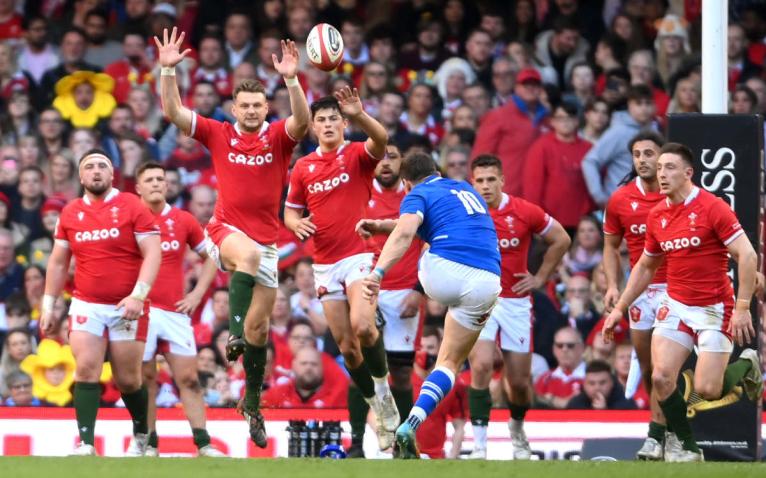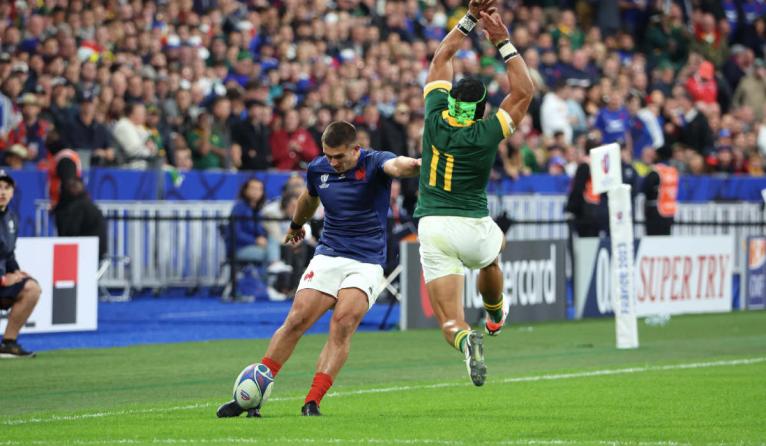George Ford’s conversion-that-never-was triggered a cascade of booing around Twickenham and some impassioned debate afterwards.
The controversy swirled around whether the England stand-off had started his run-up or not when Rio Dyer and Elliot Dee charged the kick.
Was Ford’s movement just a Time Warp-style jump to the left or was it the beginning of his actual approach?
The Fordy Horror Show has been a noisy enough discussion point as it is but just imagine if England had lost to Wales by a point instead of winning by two.
Which begs the question of whether conversion charge downs should be part of rugby union at all.
They are there because they have always been there but why exactly?

It is inconsistent, surely, that players are allowed to charge a conversion but not a penalty kick.
Spectators tuning in to rugby union for the first time from one of Jupiter’s watery moons would certainly be perplexed.
Stationary humanoid form in one scenario; dynamic humanoid in parallel scenario.
Failure to compute.
Rugby union sometimes seems to take a perverse pride in its impenetrability but an incompatibility like this adds unnecessarily to its complexity.
Since 1894, when the try first leapfrogged it in terms of value, the conversion has had to deal with its own declining relative importance. It has lived with that just as it has the implementation of the shot clock.
So why not just do away with it?
The conversion has been on a journey throughout the game’s history.
Back in the 19th Century it used to be the big deal in rugby.
Touching the ball down over the goal line was merely the set-up to ‘try’ for a kick at goal. And goals decided who won the game.
When the first points scoring system was introduced in 1886 the conversion was awarded two points and the try one which showed where the balance of power still lay.
But since 1894, when the try first leapfrogged it in terms of value, the conversion has had to deal with its own declining relative importance.
It has lived with that just as it has the implementation of the shot clock.

Back in the 19th Century it used to be the big deal in rugby.
Touching the ball down over the goal line was merely the set-up to ‘try’ for a kick at goal. And goals decided who won the game.
When the first points scoring system was introduced in 1886 the conversion was awarded two points and the try one which showed where the balance of power still lay.
But since 1894, when the try first leapfrogged it in terms of value, the conversion has had to deal with its own declining relative importance.
It has lived with that just as it has the implementation of the shot clock.
It has proved it can adapt.
The law surrounding charging a conversion has been a moveable feast too.
The ball used to be held in place for a kicker by a teammate with players allowed to charge as soon as the ball made contact with the ground.
In 1958 changes were applied to put the brakes on the chargers. They had to stay in their blocks until the kicker’s run-up began.
This had the effect of making the placer redundant – except when it was blowing a gale.
It was Ford’s attempt to eat up his full allocation of 90 seconds on the shot clock in order to run down England’s sin-bin slammer time which precipitated the issue at Twickenham. It served to draw attention to him and put any movement under the microscope.
The unintended consequence was having to decide when a kicker had begun their run-up and therefore what constituted a green light for the greyhounds behind the goal line to go.
The relevant law states: “All players retire to the goal line and do not overstep that line until the kicker begins the approach to kick.
“When the kicker does this, they may charge or jump to prevent a goal.”
But the decision is so subjective.
On Saturday referee James Doleman ruled that Ford’s sidestep – away from the posts though it may have been – marked the beginning of his approach.
A perplexed Ford argued otherwise afterwards, claiming he was going to have to stand like a statue in future.
It was Ford’s attempt to eat up his full allocation of 90 seconds on the shot clock in order to run down England’s sin-bin slammer time which precipitated the issue at Twickenham.
It served to draw attention to him and put any movement under the microscope.
In the circumstances it was hard to feel too much sympathy with Ford.

But referees have enough on their plates anyway with actual rugby decisions rather than having to rule on games of non-musical statues. Officials would be better off if they never had to be put in this position.
Rugby league requires defending players to remain behind the goal line for all kicks at goal.
Union should follow its lead. The charge down is more trouble than it is worth.
Attempting one may keep wingers warm on cold winter’s days when they are seeing little of the ball but in general they are futile.
When they are successful, all hell tends to break loose.
Rugby union is a game of shades of grey, not black and white, and there will always be contentious areas but charge down kicker twitches it can do without.
Remember Cheslin Kolbe and the World Cup quarter-final?
France full-back Thomas Ramos will argue until his dying day that Kolbe jumped the gun on his conversion charge down.
Referee Ben O’Keeffe ruled otherwise, the chance of two points went begging and South Africa prevailed 29-28.
The furore was predictable.
Rugby union is a game of shades of grey, not black and white, and there will always be contentious areas but charge down kicker twitches it can do without.
Penalty charge downs were outlawed in 1925. Ninety-nine years on, it is high time the conversion equivalent went the same way.



Yes, allow the charge down. And to stop time-wasting why not turn it around, so that after 45 seconds, say, a hooter/the whistle goes and the opposition are allowed to charge? And I’d be tempted to add, for penalties as well.
And seeing I’m moved to comment, please bring back the straight put in for scrums. Why should line-outs be contested but not scrums? If the powers that be don’t want a contest, why not just make it a tap while the forwards have to stand together holding hands for the count of five?
Because it was England
Leave the charge down. It adds spice to the game . And rewards another skillset . It was not by chance that Kolbe effected the charge down vs France. Springboks apparently practiced charge downs and hard work in that department paid off . Refs today have benefit of technology to assist them.
Drop the Charge Down completely and allow players to recover in the time window. Reduce the shot clock to 45 seconds from the second a shot is called by the referee - this will stop time wasting, and increase pressure on the kicker without affecting player recovery - hopefully leading to a more intense game of rugby.
“It is inconsistent, surely, that players are allowed to charge a conversion but not a penalty kick.“ No, it’s not. A penalty is a punishment. A try is a reward.
Regarding the start of the kicker’s run-up, apparently the law states that when the kicker starts moving IN ANY DIRECTION to take the kick, the opposition can charge (Fact check me on this). Therefore, if a kicker has the kick lined up and then takes a step backward before moving towards the ball, the charge can start with the step backwards.
I am English, but I believe Ford was rightly charged down. He had stepped back, then stood for at least 5 seconds before a slight move to his left. Opposition players all watch his kicking routine and technique and know when he is going to actually start his run-up to kick. Ford lost out because he was trying to eke out more seconds off the two-players sin-bins. I like Mark 30 second max time once the tee is on the pitch. Check how quick a conversion is when the try-scoring team needs another score to win.
Yes, it’s probably the right suggestion to scrap the charge down altogether; it adds nothing to the game. Pity we didn’t hear these voices saying the same thing after the Ramos/Kolbe incident
I don’t follow your argument here.
You think charge downs should be scrapped because….? It makes life easier for the ref? I can’t see any other reasoning in your article.
Following to absurdity, why not scrap all the rules. Then we don’t need a ref at all?
Or… you know… why not just accept the rules are the rules and play the game. Ford messed up. Kolbe made an incredible impact on the game. It all adds to the drama and the spectacle.
Why do we have so long on the shot clock? Thirty seconds is more than enough. The spectators at Twickenham paid a lot of money to watch 80 minutes of rugby but were presented with long periods of inactivity caused by kickers determined to take every second of the allowed time to take their kicks, minutes of waiting for scrums to form only for them to be reset again and teams taking forever to form the line outs. A possible solution for the conversion fiasco would be that only 30 seconds maximum is allowed from the point when the referee deems that the kick can be taken ( ie the ball is in the right place, the opposition is behind the goal line and the kicking tee is available to the kicker). At that point, the referee calls “time on” , blows the whistle and raises his arm to alert all players that the game has resumed and that the kicker now has 30 seconds to place the ball, and take the kick. After 20 seconds, the referee drops his arm which signals to the opposition that they can now charge the kicker, whether the kicker has started his run up or not. They are not allowed to charge the kick under any circumstances until 20 seconds have elapsed. If the penalty was awarded before 80 mins, but the kicking process is not completed before until after the 80 mins is up, then the game restarts and carries on until the ball next goes dead. The result would be a faster game, kickers forced to have the skill to kick promptly, the opposition given a chance to punish slow kicking and prevent kickers killing exciting games by running down the last two or three minutes, and I think create an exciting spectacle for the crowd